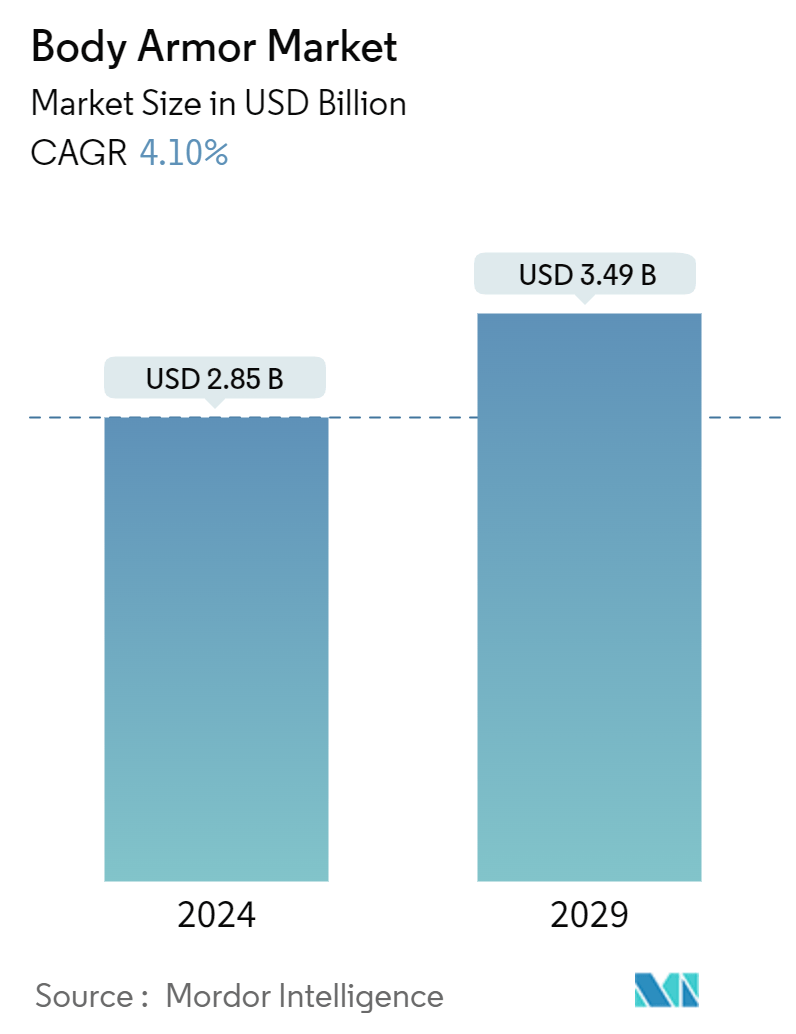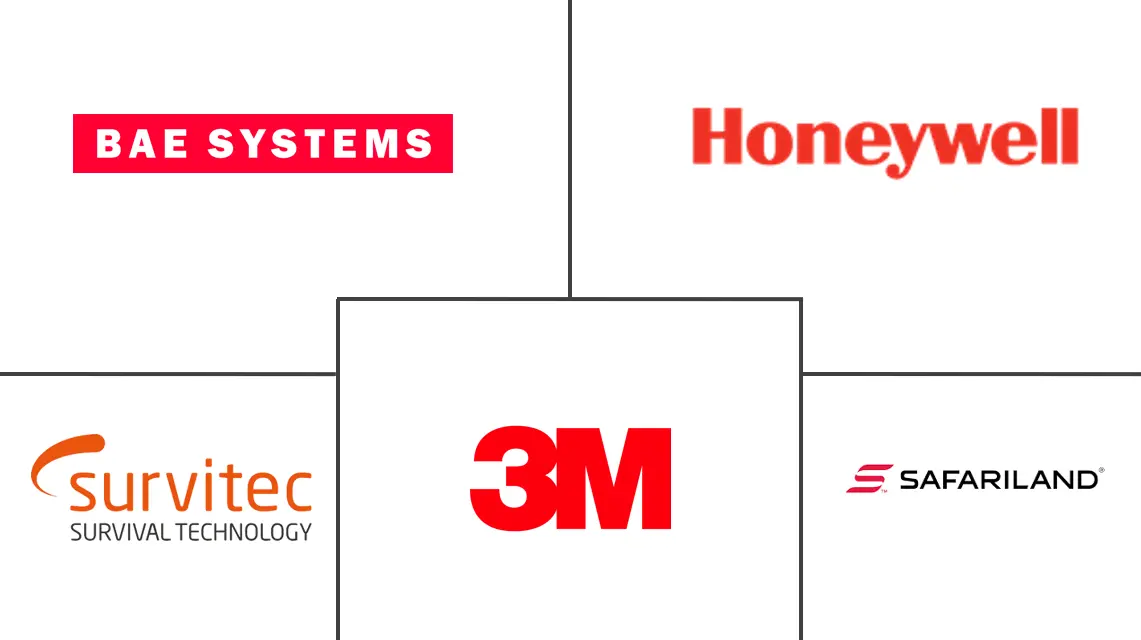Market Size of Body Armor Industry

| Study Period | 2019 - 2029 |
| Market Size (2024) | USD 2.85 Billion |
| Market Size (2029) | USD 3.49 Billion |
| CAGR (2024 - 2029) | 4.10 % |
| Fastest Growing Market | Latin America |
| Largest Market | North America |
Major Players
*Disclaimer: Major Players sorted in no particular order |
Body Armor Market Analysis
The Body Armor Market size is estimated at USD 2.85 billion in 2024, and is expected to reach USD 3.49 billion by 2029, growing at a CAGR of 4.10% during the forecast period (2024-2029).
Geopolitical tensions and a surge in violence and terrorism have underscored the importance of body armor for military and law enforcement agencies, safeguarding their personnel in diverse scenarios. However, the level of protection varies, tailored to the specific threat assessments.
Military engagements, spanning counterinsurgency, counter-terrorism, and guerrilla warfare, pose significant risks, potentially leading to injuries or fatalities. Similarly, in law enforcement, officers face threats from criminals and felons, necessitating investments in personal body armor.
The body armor market's growth is not solely driven by military demand but increasingly by law enforcement and civilian sectors. Innovations like flexible, lightweight body armor, including Kevlar-based soft armor, prioritize protection and wearer comfort. This demand is fueling market expansion, particularly in regions facing heightened security challenges. Noteworthy advancements like DuPont and Point-Blank Enterprises' Kevlar EXO further propel market growth.
However, the market grapples with a significant hurdle: the integration costs of advanced materials, such as ultra-high-molecule weight polyethylene (UHMWPE) and advanced ceramics, significantly elevate production costs, limiting widespread adoption.
In recent years, there has been a notable increase in investments in advanced body armor, spurred mainly by governments aiming to bridge supply-demand gaps. Consequently, the market is witnessing heightened procurement and development activities, setting the stage for robust growth. Yet, stringent government regulations, especially in the civil sector, act as a counterbalance, impeding the market's full potential.
Body Armor Industry Segmentation
Body armor, personal armor, armored suit, and coat of armor are defined as protective clothing designed to absorb or deflect physical attacks. It has historically been used to protect military personnel. It is also used by various law enforcement agencies (riot police in particular), private security guards, bodyguards, and occasionally ordinary citizens.
The body armor market is segmented based on product type, end users, and geography. The market is further segmented by product type into soft and hard armor, clothing, helmets, and accessories. The market is classified into military, civil, and law enforcement by end user. The report also offers the market size and forecasts for major countries across different regions. The market size is provided for each segment in terms of value (USD).
| Product Type | |
| Soft and Hard Armors | |
| Clothing | |
| Helmets | |
| Accessories |
| End User | |
| Military | |
| Civil and Law Enforcement |
| Geography | |||||||
| |||||||
| |||||||
| |||||||
| |||||||
|
Body Armor Market Size Summary
The body armor market is experiencing a significant expansion driven by increasing geopolitical tensions and the rising need for enhanced protection in military and law enforcement sectors. The demand for body armor is not only fueled by military engagements but also by the growing requirements in civilian and law enforcement domains. Innovations in materials science, such as the development of flexible and lightweight armor systems, are playing a crucial role in this growth. These advancements, including the use of Kevlar-based soft armor, are designed to offer superior protection while ensuring comfort for the wearer. The market is witnessing robust growth, particularly in regions with heightened security challenges, as entities like NATO and various defense organizations invest heavily in upgrading their protective gear. However, the high costs associated with integrating advanced materials, such as ultra-high-molecular-weight polyethylene and advanced ceramics, pose challenges to widespread adoption.
North America stands out as a key player in the body armor market, driven by substantial investments and innovations in materials and manufacturing processes. The United States, as the largest defense spender, is focusing on modernizing its military gear, including body armor, to address threats from strategic adversaries. The market is characterized by strategic partnerships and acquisitions, enhancing the capabilities and product offerings of major players like DuPont, Point Blank Enterprises, and Survitec Group Limited. These collaborations are aimed at developing next-generation body armor solutions that meet the evolving demands of military and law enforcement personnel. Despite the market's growth potential, stringent government regulations, particularly in the civil sector, continue to act as a counterbalance, influencing the market dynamics. The semi-consolidated nature of the market, with significant shares held by local and global players, underscores the competitive landscape and the ongoing efforts to innovate and meet the diverse protective needs across various sectors.
Body Armor Market Size - Table of Contents
-
1. MARKET DYNAMICS
-
1.1 Market Overview
-
1.2 Market Drivers
-
1.3 Market Restraints
-
1.4 Porter's Five Forces Analysis
-
1.4.1 Bargaining Power of Buyers
-
1.4.2 Bargaining Power of Suppliers
-
1.4.3 Threat of New Entrants
-
1.4.4 Threat of Substitute Products
-
1.4.5 Intensity of Competitive Rivalry
-
-
-
2. MARKET SEGMENTATION
-
2.1 Product Type
-
2.1.1 Soft and Hard Armors
-
2.1.2 Clothing
-
2.1.3 Helmets
-
2.1.4 Accessories
-
-
2.2 End User
-
2.2.1 Military
-
2.2.2 Civil and Law Enforcement
-
-
2.3 Geography
-
2.3.1 North America
-
2.3.1.1 United States
-
2.3.1.2 Canada
-
-
2.3.2 Europe
-
2.3.2.1 United Kingdom
-
2.3.2.2 Germany
-
2.3.2.3 France
-
2.3.2.4 Russia
-
2.3.2.5 Rest of Europe
-
-
2.3.3 Asia-Pacific
-
2.3.3.1 China
-
2.3.3.2 India
-
2.3.3.3 Japan
-
2.3.3.4 South Korea
-
2.3.3.5 Rest of Asia-Pacific
-
-
2.3.4 Latin America
-
2.3.4.1 Brazil
-
2.3.4.2 Rest of Latin America
-
-
2.3.5 Middle East and Africa
-
2.3.5.1 United Arab Emirates
-
2.3.5.2 Saudi Arabia
-
2.3.5.3 Israel
-
2.3.5.4 South Africa
-
2.3.5.5 Rest of Middle East and Africa
-
-
-
Body Armor Market Size FAQs
How big is the Body Armor Market?
The Body Armor Market size is expected to reach USD 2.85 billion in 2024 and grow at a CAGR of 4.10% to reach USD 3.49 billion by 2029.
What is the current Body Armor Market size?
In 2024, the Body Armor Market size is expected to reach USD 2.85 billion.

